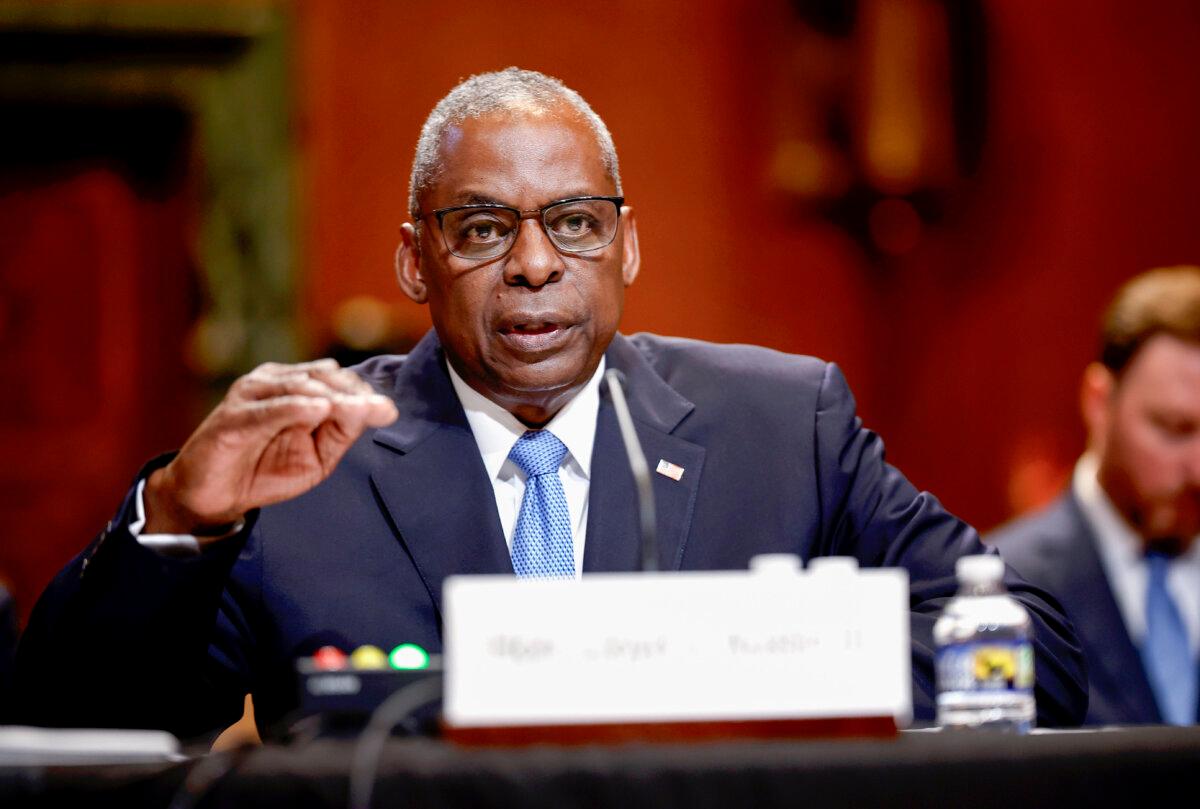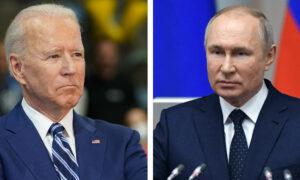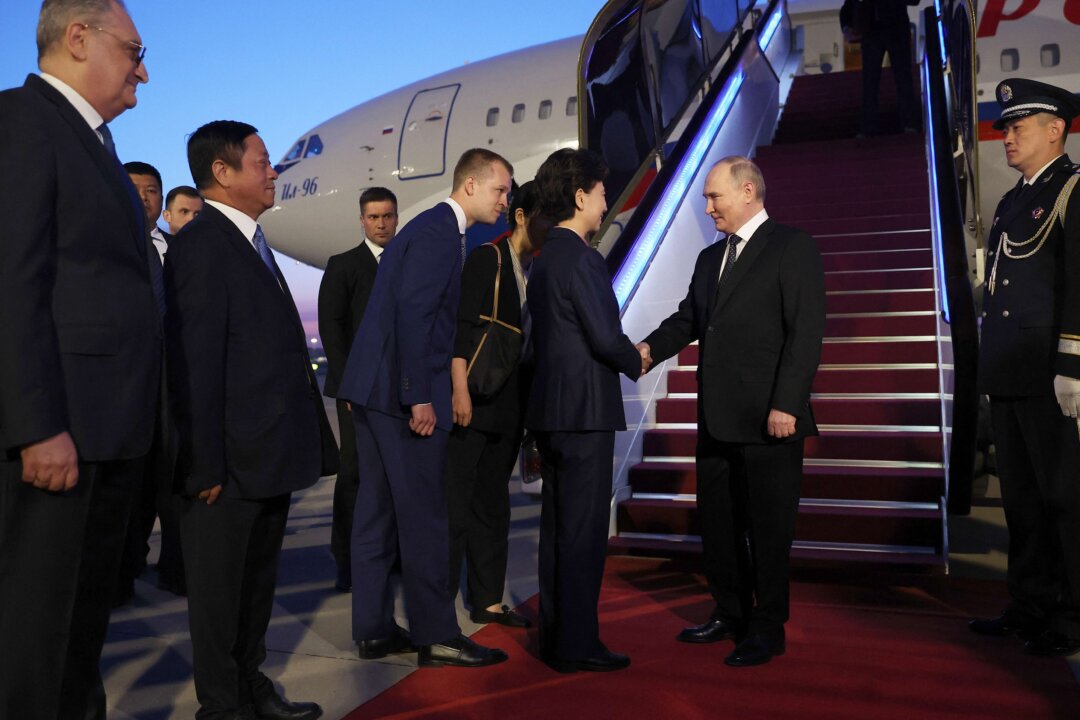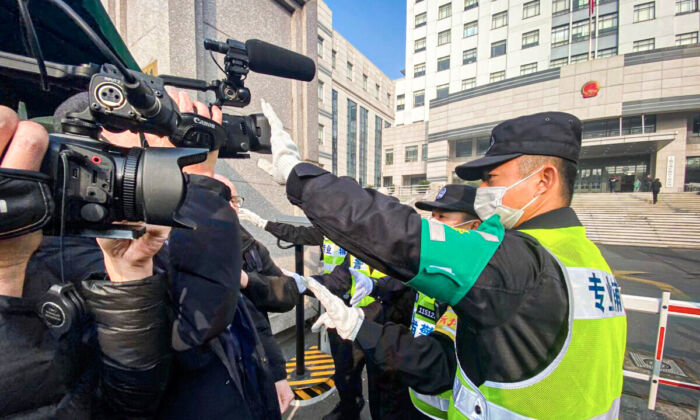Former Pentagon adviser says Kremlin has 10 times the tactical nukes its Western adversaries have and may be tempted ’to roll the dice' in pressing advantage.
News Analysis
While it’s easy to dismiss Russia’s most recent threat to use tactical nuclear weapons, the circumstances and specificity—menacing British military installations “outside Ukraine"—are raising eyebrows, if not overt alarm.
“Oh, I for sure think it’s real,” said Robert Peters, a research fellow for Nuclear Deterrence and Missile Defense at The Heritage Foundation’s Allison Center for National Security.
“Russia has been telegraphing nuclear threats for 18 months,” he told The Epoch Times. “It has performed miserably in Ukraine. This has become regime survival for [Russian Federation President Vladimir] Putin.
“If he loses in Ukraine, that’s the end of the system he’s spent a quarter-century building; of course, he’d use nuclear weapons to defend that system.”
But Center for Arms Control & Non-Proliferation Senior Policy Director John Erath said the Kremlin’s threat to use tactical “low-yield” nuclear weapons doesn’t make sense since Russia has ample conventional munitions it’s “shown no hesitancy to use.”
“They are already using their nuclear weapons. They have made a very clear choice to use their nuclear weapons, including their non-strategic weapons, as a tool of diplomacy—for blackmail,” he told The Epoch Times.
The Kremlin warned the United Kingdom and France that if weapons they provide Ukraine are used inside Russia, or if they send troops to assist Kyiv, they are “de facto recognized” as combatants and risk attack.
Russia’s Defense Ministry spokesman Dmitry Peskov said on May 6 that Russian forces will stage tactical nuclear weapons exercises in “the immediate future” in response to “provocative statements and threats of certain Western officials.”
The ministry cited statements by UK Foreign Secretary David Cameron that Kyiv “has that right” to use British weapons to strike inside Russia, and by French President Emmanuel Macron that French troops could “have a role to play” in Ukraine.
That rhetoric simmered further after UK Ambassador to Russia Nigel Casey was summoned to Russia’s Foreign Ministry to field a formal protest.
Both sides claim they lectured each other during the discussion, which Russians call a rebuke and the British describe as a meeting.
In an ensuing statement, the Kremlin warned the UK that “any British military facilities and equipment on the territory of Ukraine and abroad could be targeted,” stressing UK military bases “outside Ukraine” are fair game.
Mr. Putin and the Kremlin have been threatening to use tactical nuclear weapons with increasing frequency since Russia’s February 2022 invasion of Ukraine.
This round, too, has generally been dismissed.
The Pentagon, for instance, announced no precautionary actions in response to the threats.
 Missiles that can carry nuclear and conventional warheads on parade in Beijing, China, on Oct. 1, 2009. (Feng Li/Getty Images)
Missiles that can carry nuclear and conventional warheads on parade in Beijing, China, on Oct. 1, 2009. (Feng Li/Getty Images)Could Russia Press Advantage?
But Russia has the world’s largest, most diverse, and advanced tactical nuclear weapons arsenal.
It has about 1,560 non-strategic weapons capable of being delivered by land, air, and sea systems—even by drone, the Kremlin claims—while the United States has about 150 “low-yield” battlefield nukes.
It’s an arsenal Russia has invested heavily in the past two decades. As the saber-rattling indicates, it’s an advantage the Kremlin is very aware of, Mr. Peters said.
“People forget Russia has 10 times the number of non-strategic nuclear weapons as the United States and people think, ‘Well, these are ‘low-yield’ weapons,’” not the massive mushroom cloud planet-enders.
“The problem is, they have 2,000 arrayed against Western Europe … and some of them are pretty big[-yield]. People forget that.”
That’s apparently what Russia is reminding people of with its threats.
The specificity of the threat, to strike at British bases “beyond Ukraine” in one statement and “outside Ukraine” in another, poses a potential nightmare scenario.
While Russia, or China, may not “strike the United States [or NATO] in a way that forces it to unload its strategic arsenal on them,” Mr. Peters said, “they could be tempted to roll the dice and say, ‘If I use a small number of low-yield nuclear weapons within a confined theater of operations against military targets … maybe I’m tempted.’”
That could put the United States in a position where its only option is a world-ending nuclear exchange.
“That creates so many dilemmas for American presidents and for the U.S. military,” he said. “That really concerns me—it really concerns me.”
 Secretary of Defense Lloyd Austin testifies on the proposed $894 billion Fiscal Year 2025 defense budget, which earmarks nearly $50 billion for nuclear weapons, before the Senate Appropriations Committee in Washington on May 8, 2024. (Kevin Dietsch/Getty Images)
Secretary of Defense Lloyd Austin testifies on the proposed $894 billion Fiscal Year 2025 defense budget, which earmarks nearly $50 billion for nuclear weapons, before the Senate Appropriations Committee in Washington on May 8, 2024. (Kevin Dietsch/Getty Images)Huge Decision Ahead
Russia’s tactical nuclear weapons advantage “needs most urgent attention” as Congress deliberates on President Joe Biden’s proposed $894 billion Fiscal Year 2025 (FY25) defense budget in coming weeks, Mr. Peters said.
This requires a policy update to go along with the Pentagon’s 30-year $1.5 trillion program to modernize the nation’s nuclear triad—land-based intercontinental ballistic missiles (ICBMs), submarine-launched missiles, and Air Force bombers.
The Congressional Budget Office in July estimated modernization plans outlined under Mr. Biden’s October 2022 Nuclear Posture Review (NPR) would cost $756 billion between 2023-32, about $75 billion a year.
The Biden administration’s proposed defense budget earmarks $49.2 billion to modernize the triad. It has committed $140.9 billion to modernization over the past three years.
The spending proposal incorporates none of the 81 recommendations in the Congressional Commission on the Strategic Posture of the United States October 2023 report that said $50 billion—even $75 billion—a year is “not sufficient” to counter advances by Russia and China.
During a Nov. 15 hearing before the House Armed Services Committee, chair Rep. Mike Rogers (R-Ala.) said among the differences between Mr. Biden’s NPR and the report is the commission’s urgency in identifying Russia’s “alarming stockpile of nuclear weapons” as a real threat.
While “threat conditions are changing, much of [Mr. Biden’s] NPR appears frozen in the naively optimistic post-Cold War years; it suggests no urgency with regard to U.S. responses to mounting threats,” writes Dr. Keith B. Payne, co-founder of the National Institute for Public Policy and Missouri State University Graduate School of Defense and Strategic Studies professor, in a February analysis.
The SPC’s report is “what Biden’s NPR should have been,” said Mr. Payne, a former Deputy Assistant Secretary of Defense and senior adviser to the Secretary of Defense.
 Russian President Vladimir Putin (C) and Russian Navy Commander-in-Chief Adm. Nikolai Yevmenov, visit a new frigate armed with tactical nuclear weapons systems in December 2023. (Mikhail Klimentyev, Sputnik, Kremlin Pool Photo via AP)
Russian President Vladimir Putin (C) and Russian Navy Commander-in-Chief Adm. Nikolai Yevmenov, visit a new frigate armed with tactical nuclear weapons systems in December 2023. (Mikhail Klimentyev, Sputnik, Kremlin Pool Photo via AP)Points-Counterpoints
Mr. Peters, who served as special adviser to the Secretary of Defense during the 2010 New START talks and in assembling the 2010 NPR, said there’s a way to swiftly boost the U.S. tactical nuclear weapons arsenal.
“If I were advising the president, what I would say is we don’t have time to build the non-strategic weapons we need over the next 10 years.
“We need to take the warheads out of ready reserves, those decommissioned warheads out of the stockpile, and slap them on existing cruise missiles and ballistic missiles,” he said.
It would “not be utterly perfect,” Mr. Peters said, “but good enough to make Putin and Xi Jinping say, ‘Ah, okay, you know what? I don’t want to fight this war today.’”
Russia’s most recent threats guarantee the Kremlin would use tactical nukes if things go badly in Ukraine, he said.
“NATO entering the war as a co-belligerent would mean Russia losing that war,” Mr. Peters said. “Of course, it’s a serious threat—that’s my biggest concern across our entire deterrence posture.
“We have a real problem on the non-strategic side of the house.”
Scrambling to expand tactical nuclear arsenals would essentially mean Russia’s intimidation has worked, Mr. Erath said, prefacing what will be a point-counterpoint debate to unfold in summer hearings.
“It’s important to note in SPC’s report, there was not a specific recommendation to increase the number of U.S. nuclear forces.
“It is very carefully worded, saying this is something that might need to be considered if current trends continue. It’s very specifically worded not to say [that] we need more nukes now,” he said.
Tactical nuclear weapons “are not really significant in the military sense,” Mr. Erath said, “but they’re being used regularly as a tool of intimidation, as we saw again this week.”
The Pentagon and NATO will certainly be paying attention to whatever drill the Russians stage, not because there’s alarm about one being launched but because, as when Russia seized Crimea in 2014 “under the guise of conducting an exercise,” there’s always concern “a publicized drill is cover for something else,” he said.
But by raising fear in Europe and Congress, “they’re getting a little more intimidation for their money here,” Mr. Erath said.














 English (US) ·
English (US) ·  Turkish (TR) ·
Turkish (TR) ·